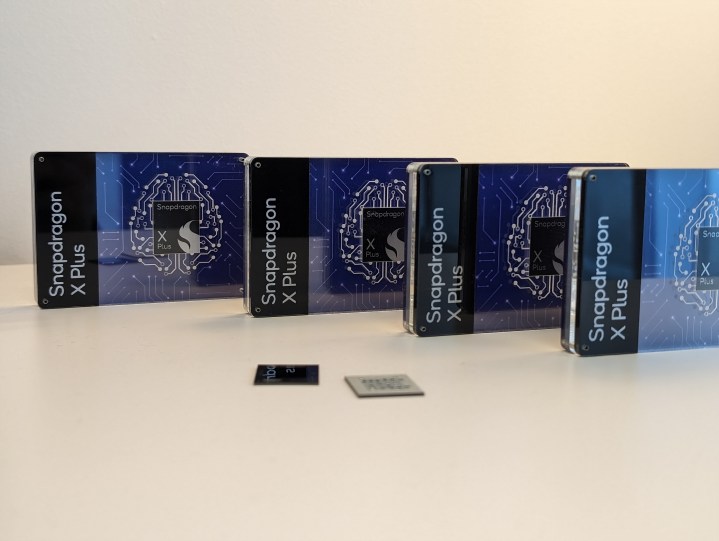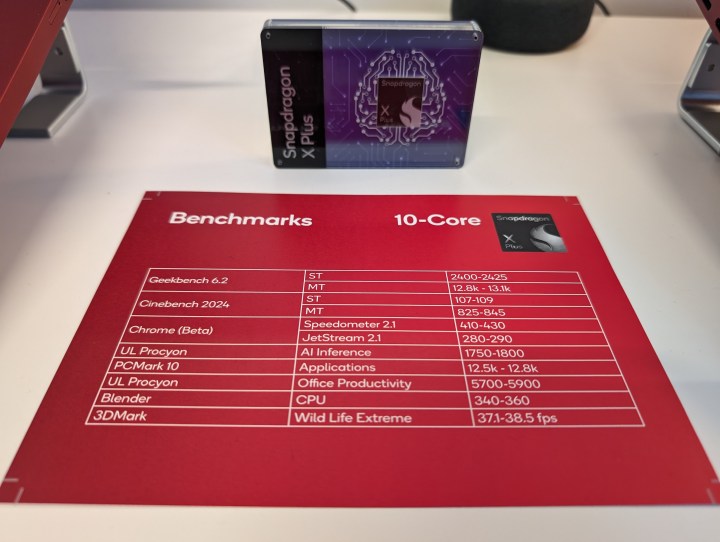
You might have already heard of the Snapdragon X Elite, the upcoming chips from Qualcomm that everyone’s excited about. They’re not out yet, but Qualcomm is already announcing another configuration to live alongside it: the Snapdragon X Plus.
The Snapdragon X Plus is pretty similar to the flagship Snapdragon X Elite in terms of everyday performance but, as a new chip tier, aims to bring AI capabilities to a wider portfolio of ARM-powered laptops. To be clear, though, this one is a step down from the flagship Snapdragon X Elite, in the same way that an Intel Core Ultra 7 is a step down from Core Ultra 9.
Qualcomm has built this chip with efficiency and speed in mind, claiming that the new Snapdragon X Plus is 10% faster than the Apple M3 chip in multi-threaded CPU performance. Geekbench 6 multi-core scoring has it at 13,350, against the Apple M3’s 12,154. Qualcomm also holds that when running at the same power level, the Snapdragon X Plus is 37% faster than Intel’s latest Core Ultra 7 155H chip in Geekbench multi-threaded performance while using 54% less power.
Interestingly, when you consider the provided Cinebench R24 scores (107-109/825-845) against the M3, it leans even more heavily in Qualcomm’s favor. The multi-core test in Cinebench R24 produces results for the Snapdragon X Plus that are 29% faster than our testing of the M3 in the 13-inch MacBook Air (141 / 601). I should note that the reported single-core score in Cinebench R24 for the Snapdragon X Plus is significantly slower than our own results testing the M3 in this same benchmark, which have hit 141.

That’s just the CPU performance, though. Qualcomm backs that the Snapdragon X Plus is up to 36% faster in GPU performance against the Core Ultra 7 155H while running with 50% less power.
This new Snapdragon X Plus XIP-64-100 is built on the same 4nm process as the Snapdragon X Elite, and packs 10 high-performance cores, running at 3.4 GHz, with a 42MB cache. It also sports a Qualcomm Adreno GPU that can deliver 3.8 teraflops of power and a 45 trillion operations per second (TOPS) NPU.
The under-the-hood difference isn’t too significant from the highest-tier Snapdragon X Elite, though. The only way the chip departs from the flagship is with the performance cores and the GPU power compared to some X Elite SKUs.
As a reference, the highest-end Snapdragon X Elite X1E-84-100 has 12 high-performance cores that can run at 3.8GHz, with dual-core boost to up to 4.2GHz, and also delivers 4.6 teraflops of power in its Adreno GPU. The mid-range Snapdragon X Elite XIE-80-100 runs at 3.4 GHz and packs a 4.0 GHz dual-core boost and 3.8 teraflops of power in the Adreno GPU. The lower-tier Snapdragon X Elite XIP-64-100 runs at 3.4 GHz and doesn’t support dual-core boost, but has a 3.8 teraflop GPU.
| Snapdragon X Plus X1P-64-100 | Snapdragon X Elite X1E-84-100 | Snapdragon X Elite X1E-80-100 | Snapdragon X Elite X1E-78-100 | |
| CPU cores | 10 cores | 12 cores | 12 cores | 12 cores |
| Cache | 42 MB | 42MB | 42MB | 42MB |
| Multithread frequency | 3.4GHz | 3.8GHz | 3.4GHz | 3.4GHz |
| Dual-core boost | None | 4.2 GHz | 4.0GHz | None |
| GPU (TFLOPS) | 3.8 | 4.6 | 3.8 | 3.8 |
| NPU (TOPS) | 45 | 45 | 45 | 45 |
Packing a 45 TOPS NPU, just like the X Elite, the Snapdragon X Plus does have a lot of great AI capabilities. I got to see demos of code generation in Visual Studio, Music generation in Audacity, and Live captions in OBS Studio. Qualcomm is claiming that the 45 TOPS NPU is the world’s fastest NPU in laptops.
If you’re wondering how the Snapdragon X Elite stacks up against the highest-end Snapdragon X Plus, a table with a comparison can be seen below. The differences aren’t too far off, showing how much value this new chip packs.
| Test performed | Snapdragon X Elite | Snapdragon X Plus |
| Geekbench 6.2 (Single/Multi) | 2,850-2,900/15,100-15,400 | 2,400-2,425/12,800-13,100 |
| Cinebench 2024 (Single/Multi) | 126-128/1,140-1,200 | 107-109/825-845 |
| Web browsing (Speedometer/Jetstream) | 460-500/330-340 | 410-430/280-290 |
| UL Procyon AI | 1,740-1,800 | 1,750-1,800 |
| PCMark10 | 13,500-14,100 | 12,500-12,800 |
| UL Procyon Office | 6,500-6,900 | 5,700-5,900 |
| Blender | 430-470 | 340-360 |
| 3DMark | 41.9-44 FPS | 37.1-38.5 FPS |
The first laptops with the Snapdragon X Plus will ship out starting in mid-2024, right alongside laptops with the flagship Snapdragon X Elite.
An exact price point was not shared, but we were told factors like the screen size, battery, and other components set by the laptop maker could impact pricing. We’ve already seen supposed leaked Geekbench 6 benchmarks for what could be a Surface Pro 10 with the Snapdragon X Plus, and it netted scoring in line with what Qualcomm shared today.
Editors’ Recommendations
- My most anticipated laptop of the year just got leaked
- There’s an unexpected, new competitor in PC gaming
- Here’s proof that Snapdragon X Elite laptops can play hit games without issue
- Qualcomm claims its new chips are 21% faster than Apple’s M3
- Apple’s new M3 Pro might come with an unexpected downgrade
![]()
Arif Bacchus is a native New Yorker and a fan of all things technology. Arif works as a freelance writer at Digital Trends…
Apple’s new M3 looks fast, but will it really be worth the upgrade?

The new Apple M3 is the “most advanced chip ever built for a personal computer,” according to Apple. Debuted during Apple’s “Scary Fast” event and sporting a new process, the M3 promises up to 60% higher performance in some apps. But will it really be worth an upgrade over the M1 or M2?
We’ve already seen the M2 at work in devices like the Mac mini, and we’ll have to wait until the M3 launches to really know how it performs. But based on what we know right now, here’s how the M3 stacks up to the M2.
Apple just did something unprecedented with its new M3 chips

Apple announced the M3 series of chips today but has switched up the rollout in a significant way. In previous years, the company started with the base configuration of the chip series, whether that’s the M1 or the M2. The initial releases would build the foundation of what these chips could do on entry-level devices like the MacBook Air or Mac mini.
Intel rolls out its chips in a similar way, starting its annual refresh of laptop chips with its entry-level stuff first.
Snapdragon X Elite is a showstopper chip arriving at the worst possible time

While Apple has been making huge strides with its own Mac chips in recent years, we haven’t really seen anything in the Windows world that can match it for both performance and efficiency at the same time. Now, Qualcomm is claiming its upcoming Arm-based Snapdragon X Elite chips can finally do just that — but there’s a serious catch involved.
According to PC World, Qualcomm demoed the Snapdragon X Elite at its Snapdragon Technology Summit, where the chipmaker claimed that its latest efforts would trounce everything that came before it, in particular Intel’s 13th-generation processors.
[ For more curated Computing news, check out the main news page here]
The post Even the new mid-tier Snapdragon X Plus beats Apple’s M3 | Digital Trends first appeared on www.digitaltrends.com





/cdn.vox-cdn.com/uploads/chorus_asset/file/25546355/intel_13900k_tomwarren__2_.jpg)








